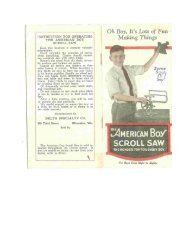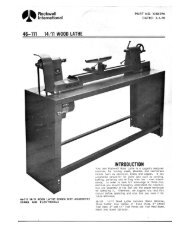You also want an ePaper? Increase the reach of your titles
YUMPU automatically turns print PDFs into web optimized ePapers that Google loves.
VEE GROOVES. Cutting the vee groove demands much<br />
the same technique as the bead, except the skew is<br />
hinged straight into the work without rotatiol\ as<br />
shown in Fig. 70. Only one-half of the vee is made<br />
at a time, and one, two or more cuts may be needed<br />
on each side to obtain the desired shape. As in all<br />
cutting with the skew, the bevel next to the cut must<br />
be used as a fulcrum, without at the sametime allowing<br />
the full edge of the chisel to catch and cause a run.<br />
Vee grooves can also be madewith the toe of the shew,<br />
in the manner already described for squaring an end.<br />
::-.--<br />
-.<br />
LONG-CONVEX<br />
CUT WIT'"' GOUGE<br />
Fig 71<br />
START TAPER WIT~ HEEL OF<br />
SKEW -ALlVAY.5" cur DOll/IIHtll.,<br />
~<br />
~Fig 73<br />
&Fig 74<br />
COVE CUTS. Second to forming a perfect bead, the<br />
cove or concave cut is the most difficult to master.<br />
This cut is made with the gouge, the size of the tool<br />
depending upon the size of the cut. The size of the<br />
intended cove is first laid out, and the gouge is pushed<br />
directly into the work to remove the surplus stock,<br />
as pictured in Fig. 76. The cove cut can now be made.<br />
LONG CUTS. Long cuts are usually either convex<br />
or straight-tapered surfaces. <strong>With</strong> a convex surface,<br />
the method used in making the finishing cut is shown<br />
in Fig. 71 and 72. The gouge is turned on the tool<br />
rest so that it will be inclined considerably in the<br />
direction in which it is about to move. The grind is<br />
tangent to the work, and the center point of the cutting<br />
edge is the contact point with the wood. As the cut<br />
progresses towards and around the end of the curve,<br />
the handle is gradually raised and swung to the right,<br />
as shown in Fig. 72, in order to maintain the tangency<br />
between the grind and the surface being cut, as shown<br />
in Fig. 73.<br />
Figs. 74 arid 75 show the cutting of a long taper.<br />
The skew is used, and the operation differs from smoothing<br />
a cylinder only as regards the start of the cut.<br />
The starting cut should be made with the heel, as<br />
shown in Fig. 75, to prevent the tool from digging<br />
into the work. As the tool runs down the work, the<br />
chisel can be pulled back to allow the center point<br />
of the cutting edge to cut. However, the full taper<br />
can be made with the heel. There wi II be a tendency<br />
to cut too deeply at the center of the taper which<br />
should be guarded against. The direction of cutting<br />
is always downhill.<br />
18<br />
/<br />
GOUGE<br />
I








